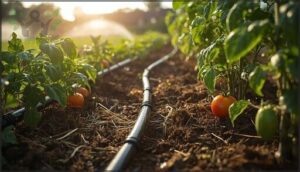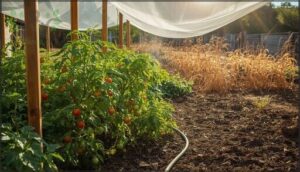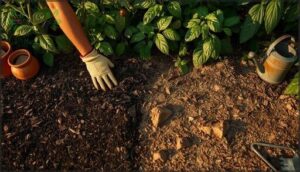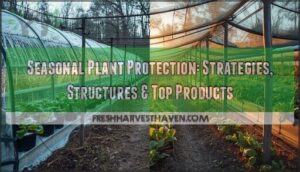This site is supported by our readers. We may earn a commission, at no cost to you, if you purchase through links.
When temperatures soar above 90°F, your garden faces a challenge that kills more plants than pests and disease combined: heat stress. The scorching sun doesn’t just wilt leaves—it fundamentally changes how water moves through soil, how roots absorb nutrients, and whether your tomatoes set fruit or simply give up.
Most gardeners know to water more during summer, but that’s only part of the story. Success in extreme heat requires rethinking everything from when you step outside to how deeply you irrigate.
The difference between a thriving garden and a crispy disaster often comes down to a few strategic adjustments that work with nature’s rhythms instead of against them.
Table Of Contents
- Key Takeaways
- Essential Safety Tips for Hot Weather Gardening
- Effective Watering Techniques in Extreme Heat
- Protecting Plants From Summer Heat
- Choosing and Caring for Heat-Tolerant Plants
- Mulching and Soil Management for Hot Climates
- Frequently Asked Questions (FAQs)
- What temperature is too hot for a garden?
- How to garden when it’s hot?
- How do different fertilizer types affect heat tolerance?
- Which containers work best in extreme temperatures?
- How does humidity impact hot weather gardening?
- What are signs of heat damage recovery?
- When should you replace heat-stressed plants?
- How do I revive heat-stressed plants?
- Can container gardens survive extreme heat?
- What soil amendments improve heat tolerance?
- Conclusion
Key Takeaways
- Heat stress kills more plants than pests or disease combined once temperatures exceed 90°F, fundamentally changing how water moves through soil and how roots absorb nutrients.
- Deep, infrequent watering—applied 2-4 times monthly to penetrate 8-12 inches—trains roots to reach cooler depths and can reduce water usage by 20-40% compared to frequent surface watering.
- Morning watering between 5:00-9:00 AM cuts evaporation by up to 40% and reduces disease risk by 30% since foliage dries quickly, preventing fungal growth from overnight moisture.
- Organic mulch applied 2-4 inches deep reduces soil evaporation by up to 60% and lowers soil temperatures by up to 10°C, acting as your garden’s most effective summer insurance policy.
Essential Safety Tips for Hot Weather Gardening
Working outside when temperatures soar can put you at serious risk if you’re not careful. The good news is that a few smart habits can keep you safe while you tend your plants.
Here’s what you need to focus on before you head out to the garden.
Hydration and Sun Protection Strategies
Under the blaze of summer sun, you need proper protection to garden safely. Stay hydrated by carrying water and taking frequent breaks—outdoor workers face a 67% dehydration risk.
Apply broad-spectrum sunscreen with SPF 30 or higher, and wear protective clothing like wide-brimmed hats. Understanding the effects of harmful UVA rays is key for preventing skin damage.
Check the UV index daily, and use shade structures or cooling technology like misting fans when temperatures climb.
Best Times of Day for Gardening Tasks
Once you’re protected, timing becomes your smartest tool. Schedule strenuous gardening tasks like planting or digging between sunrise and 10 AM—before heat stress kicks in. It’s important to avoid potential heat exhaustion by taking frequent breaks.
Here’s when to work:
- Morning vs. Evening: Water early to reduce evaporation by 30%
- Midday Risks: Avoid noon to 3 PM when ground temps spike 40°F
- Task Prioritization: Save light weeding for after 6 PM
- Scheduling Strenuous Summer Work: Cool hours protect both you and your plants
Clothing and Gear for Heat Safety
The right gear makes all the difference when you’re working outside. Lightweight, breathable fabrics cut heat stress by allowing air circulation, while light-colored clothes reflect sunshine instead of trapping it. Choose UV protection clothing with UPF 50+ ratings—it blocks 98% of harmful rays. Wide-brimmed hats with neck flaps shield your face and neck.
Here’s your heat-safe wardrobe:
| Gear Type | Heat Safety Benefit |
|---|---|
| Moisture-wicking shirts | Pulls sweat away, lowering skin temperature |
| Cooling towels or wet bandanna | Instant relief on neck and wrists |
| Ventilated straw hats | Reduces perceived temp by 1-2°C |
| Light-colored long sleeves | 20% less radiant heat absorption |
Cooling technologies like moisture-activated fabrics offer game-changing comfort during extended sessions. These gear recommendations aren’t just about comfort—they’re proven strategies for heat stress reduction that keep you gardening safely all summer long.
Effective Watering Techniques in Extreme Heat
When the thermometer climbs, your watering strategy can make or break your garden’s survival. Proper watering isn’t just about quantity—it’s about timing, technique, and understanding what your soil really needs.
Here’s how to keep your plants thriving when the heat is on.
Deep and Infrequent Watering Methods
Think of deep watering as training your plants to stand on their own during hot weather. Instead of daily surface spritzes, you’ll want to apply water less often—roughly 2–4 times per month—but soak the soil thoroughly to encourage root depth and improve drought resilience.
- Water penetrating 8–12 inches into the ground for vegetables
- Soil moisture staying stable for days, not hours
- Roots reaching down where heat can’t dry them out
- Water conservation reducing your usage by 20–40%
Morning Vs. Evening Watering
You’ll often hear that morning watering beats evening sessions, and there’s solid science behind it. Early morning hydration—between 5:00 and 9:00 AM—cuts evaporation rates by up to 40%, letting more water reach roots before midday heat strikes.
It also reduces disease risks by 30% since foliage dries quickly, preventing fungal growth from overnight moisture.
Drip Irrigation for Water Efficiency
When gardening in hot weather, drip irrigation offers serious water conservation—saving 30–70% compared to sprinklers while boosting yield increase by 20–30%. You’ll cut watering practices costs by about 25% on fertilizer, and system maintenance stays simple with automated controls reducing labor.
These environmental benefits extend beyond your garden, protecting local water quality while delivering efficient irrigation exactly where your plants need it most.
Monitoring Soil Moisture Levels
During periods of extreme heat, checking soil moisture at least every three days helps you avoid both drought stress and overwatering. Here’s how to stay precise:
- Use calibrated sensors for data accuracy—manual meters or sophisticated remote monitoring systems can cut water use by 25%.
- Adjust irrigation scheduling based on soil types, as sandy versus clay textures retain moisture differently.
- Monitor root-depth levels where mulch and soil temperature affect readings most.
Protecting Plants From Summer Heat
Even the toughest plants need a little help when temperatures climb above 90°F for days on end. The good news is you don’t need expensive equipment to shield your garden from scorching sun and baking winds.
Let’s look at three practical ways to create cooler growing conditions and give your plants the relief they need.
Using Shade Cloth and Garden Structures
Shade cloth types bring significant benefits to your heat-stressed garden. Installing reflective material can lower plant temperatures by 10 to 15 degrees, protecting plants from sun and heat while reducing soil moisture loss by up to 50%.
Choose ideal 40% shade cloth for light balance.
Structure wind resistance matters—secure your shade cover properly to withstand summer gusts while providing shade for plants during scorching afternoons.
Providing Afternoon Shade
Your plants feel afternoon heat the hardest—that’s when the sun bears down with full force. Providing shade for plants during those brutal hours can drop leaf temperatures by 10°F and slash water needs by half.
Shade materials like shade cloth or shade netting block 30% to 50% of harsh rays. Use sun assessment tools to map peak exposure, then position your shade structures.
This simple move boosts plant survival, drives yield increase through water conservation, and keeps your garden thriving when temperatures soar.
Windbreaks and Microclimate Management
Wind protection does more than stop gusts—it reshapes your garden’s microclimate. Strategic windbreak placement cuts wind speed by up to 70%, raising humidity levels and slashing evaporation by 20%.
Choose dense species for maximum shelter, but watch for seasonal variations in effectiveness. Proper air circulation prevents fungal issues while shade netting complements windbreaks.
Research shows yield improvements of 5–45% when plant protection combines wind barriers with smart design.
Choosing and Caring for Heat-Tolerant Plants
Not all plants wilt under the summer sun. Some vegetables and flowers actually thrive when temperatures climb, making them smart choices for your hot-weather garden.
Let’s look at which plants can handle the heat and how to keep them flourishing through the hottest months.
Best Heat-Resistant Vegetables and Flowers
Extreme temperatures demand smart plant choices. Okra varieties and eggplant cultivation shine when the thermometer tops 104°F, while hot peppers maintain pepper productivity far better than sweet types above 95°F.
For heat-tolerant flowers, marigolds and moss rose keep blooming past 100°F.
Don’t overlook purslane benefits—this edible green thrives in scorching conditions, offering dual-purpose heat tolerance in your hot weather gardening efforts.
Proper Plant Spacing for Airflow
Heat-resistant varieties need room to breathe. When you overcrowd plants, you’re inviting trouble—airflow stalls, humidity rises, and disease prevention falls apart. Proper plant spacing protects plant health far better than any fungicide.
Here’s what climate adaptation demands:
- Space tomatoes 3 feet apart to cut fungal disease by 40%
- Extend square foot gardening modules in humid zones
- Avoid root zone overlap—it drops yields 20% and weakens nutrient uptake
Smart spacing keeps airflow moving and your plants thriving.
Deadheading and Pruning in Hot Weather
Deadheading plants in afternoon heat stresses them further. Instead, prune spent blooms early morning or late afternoon when temperatures drop below 77°F. You’ll redirect up to 60% of energy toward new growth while cutting disease risk by a third.
Post-pruning watering raises soil moisture 10–15%, preventing wilting and leaf damage.
Weekly deadheading boosts bloom proliferation by 30–50% in responsive annuals—your summer garden stays vibrant longer.
Mulching and Soil Management for Hot Climates
Think of your soil as a bank account—when heat makes a withdrawal, mulch is your best investment to keep things in the black.
When heat drains your soil, mulch is the smartest investment you can make
Managing what’s happening beneath the surface is just as important as what you’re doing above it. Here are three key strategies to keep your soil and plants thriving when temperatures soar.
Organic Mulch for Moisture Retention
Think of mulch as your garden’s summer insurance policy. Organic materials like grass clippings and hemp offer considerable water capacity, reducing evaporation rates by up to 60% compared to bare soil. This soil temperature regulation keeps roots cooler while boosting plant yield and supporting beneficial soil biota. Your summer plant care strategy isn’t complete without proper mulching:
- Hemp mulch retains 80% of applied water over three days
- Grass clippings conserve 73% of moisture under identical conditions
- Organic mulches lower soil temperatures by up to 10°C
- Mulched plots maintain 2–4 inches of protective coverage
- Enhanced soil structure promotes stronger root development
Compost Application for Resilient Soil
Beyond mulching, compost transforms your garden’s resilience to hot weather conditions. Adding a 3-inch layer increases water retention by up to 57%, while soil nutrients like nitrogen jump 227% and phosphorus climbs 340%. You’ll see erosion control improve by 97% and microbial diversity double, strengthening disease resistance. These improvements deliver long-term yields that can persist for decades.
| Benefit | Improvement | Impact on Summer Plant Care |
|---|---|---|
| Water Retention | 35-57% increase | Extended drought tolerance |
| Soil Nutrients | 227-340% boost | Healthier heat-stressed plants |
| Erosion Control | 97% reduction | Protected garden structure |
| Microbial Diversity | 2x abundance | Enhanced disease suppression |
Adjusting Fertilization During Heatwaves
During extreme heat, you’ll want to cut your fertilizer rates to 60–70% of normal, since nutrient uptake drops sharply when temperatures soar. Apply organic fertilizer early morning between 4:00–7:00 AM, when plants absorb nutrients best.
Always water soil thoroughly before fertilizing—never feed dry, heat-stressed plants. Dilute liquid feeds to half-strength, avoiding high-nitrogen synthetics that increase burn risk by 30–40%.
Frequently Asked Questions (FAQs)
What temperature is too hot for a garden?
While many believe plants can handle any summer scorcher, most gardens hit their limit around 90°F.
Above this, you’ll notice plant stress signs like wilting, blossom drop, and slowed photosynthesis as high temperatures override normal growth.
How to garden when it’s hot?
Gardening in summer heat requires consistent water, strategic mulch layers, and timing your tasks for cooler hours.
Focus on heat-tolerant plants, deep watering practices, and protecting yourself from heat-related stress to maintain healthy gardens.
How do different fertilizer types affect heat tolerance?
Fertilizer choice shapes how your plants handle scorching days. Nitrogen boosts photosynthesis under heat stress, while organic options like cattle manure improve growth. Potassium strengthens cells, calcium protects against oxidative damage during heatwaves.
Which containers work best in extreme temperatures?
Picking proper containers preserves plant health. Container material, insulation techniques, container color, weather resistance, and container design matter most.
White containers stay coolest. Insulated, double-walled containers stabilize temperatures.
Make sure container drainage prevents waterlogging during watering and shade.
How does humidity impact hot weather gardening?
High humidity slows transpiration and moisture loss, reducing watering needs but increasing disease risk. Tropical plants thrive in hot and humid weather, while proper spacing improves airflow. Evaporation reduction helps soil moisture retention.
What are signs of heat damage recovery?
You’ll notice wilting reverses, leaves regain turgor pressure and show regreening, stem growth resumes, and new foliage emerges.
Root respiration increases, supporting biomass restoration—key plant stress indicators showing improved plant heat tolerance and survival.
When should you replace heat-stressed plants?
Replace plants showing over 50% wilting, zero regrowth after two weeks, or cellular damage exceeding 45%. Heat-sensitive plants with negative survival odds cost more to revive than replace with heat-tolerant alternatives.
How do I revive heat-stressed plants?
To revive heat-stressed plants showing wilting, apply shade cloth immediately, and guarantee deep watering practices during recovery timeframes.
Improve soil moisture through soil aeration, and delay pruning effects until stress subsides—proper shade accelerates healing.
Can container gardens survive extreme heat?
Container gardens can survive extreme heat, but success depends on daily watering practices, shade protection, and mulch management to lower root zone temps and prevent moisture loss in exposed containers.
What soil amendments improve heat tolerance?
Biochar benefits your soil by lowering bulk density and boosting moisture retention.
Compost incorporation raises organic matter, improving water-holding capacity.
Organic mulches reduce temperature fluctuations.
Calcium and potassium amendments strengthen plants before heat stress arrives.
Conclusion
Did you know that soil can lose up to 70% more moisture during a heatwave compared to cooler days? That’s why gardening in hot weather demands more than just extra watering—it’s about timing, technique, and understanding how plants respond to stress.
By adapting your habits and using smart strategies, you’re not just keeping your garden alive; you’re building resilience. Treat each summer as a lesson, and your plants will reward your care with strength, growth, and lasting beauty.
- https://www.weather.gov/images/safety/Heat_Illness.jpg
- https://www.cdc.gov/niosh/heat-stress/about/illnesses.html?CDC_AAref_Val=https://www.cdc.gov/niosh/topics/heatstress/heatrelillness.html
- https://vinesgardens.org/gardening-safely-during-a-heat-advisory-people-and-plant-care-tips/
- https://extension.missouri.edu/news/protect-yourself-from-heat-stress-in-the-garden
- https://yardandgarden.extension.iastate.edu/how-to/managing-garden-extreme-heat











